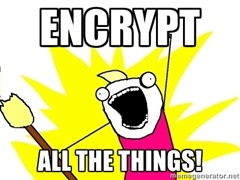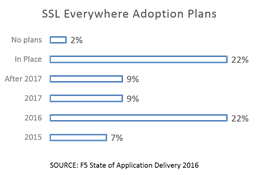すべてを暗号化する時代の可視性

中国の諺にあるように、私たちは興味深い時代に生きています。 機密性と完全性に対する意識の高まりにより、事実上「すべてのもの」を暗号化する取り組みが急増しています。
Web サイトやapplications(SSL Everywhere) であっても、内部通信 (SSH) であっても、暗号化はあらゆる組織のセキュリティ戦略の基盤であると考えられることがよくあります。

しかし、暗号化は万能薬ではなく、実際には解決する問題と同じくらい多くの問題を引き起こす可能性があります。 エンドツーエンドの暗号化により、通信(および通信で伝送されるデータ)は検査や詮索の目から安全に保護され、これは一般的に良いことです。 ただし、セキュリティ担当者がインフラストラクチャ ツールボックス内の無数のツールを使用してセキュリティの他の側面を確保できないようにする場合は除きます。
なぜなら、暗号化された悪意のあるデータは依然として悪意のあるものであり、暗号化された不正なコマンドの実行は依然として不正であるということを私たちは皆知っているからです。
私たちが写真から失っているのは可視性、つまり誰が何を、どこから、なぜやっているのかを「見る」能力です。
可視性が失われると、セキュリティ インフラストラクチャへの投資が無駄になる可能性があります。 可視性が失われ、IT 部門がデータ漏洩を検出して防止できなくなる可能性があります。 可視性が失われると、デバイス、モノ、システムを不正アクセスから保護するポリシーの適用が妨げられる可能性があります。 ガートナーの調査によると、「これらのセキュリティ デバイス [NGFW、IPS、UTM] を使用している組織の 80% は、SSL トンネルを利用してマルウェアを企業ネットワークに侵入させることで、サイバー犯罪者が組織の既存のセキュリティ制御を回避できるようにしている可能性があります...」 (SSL トラフィックにサイバー犯罪者が潜んでいますか?)
損害を引き起こす可能性のある脅威に気づかずにビジネスを運営することは、すべてのものを暗号化することで期待される結果とはまったく異なります。
フォースと同じように、バランスがなければなりません。 機密性とプライバシーを確保するために通信を暗号化する必要がありますが、セキュリティ ポリシーとプラクティスも、適用および実行に必要な可視性を備えて有効化されている必要があります。
そのため、包括的なセキュリティ戦略をサポートするあらゆるアーキテクチャでは、「スマートな」仲介者が必須となります。 悪意のある通信や不正な通信を検出して防止するために必要な可視性を損なうことなく、暗号化によって提供されるセキュリティとプライバシーを維持できる仲介者。 これらの仲介者が暗号化された通信の終端点として機能しているか、暗号化されたストリームの下にあるものを表示するだけであるかにかかわらず、これらのアーキテクチャ ゲートウェイは、すべてが暗号化されるこの時代に可視性を確保するために不可欠です。
